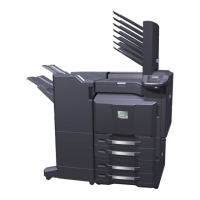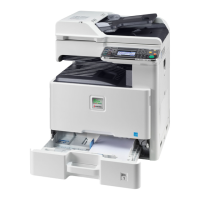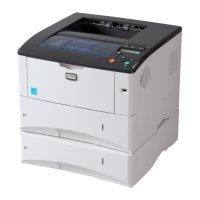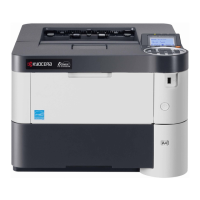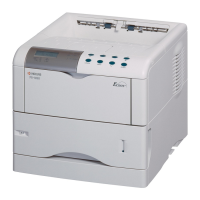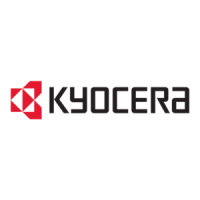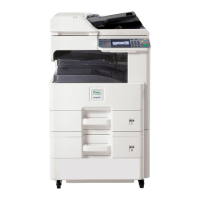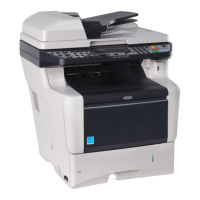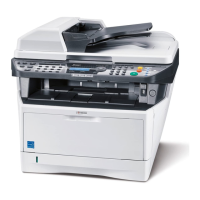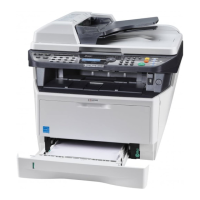Do you have a question about the Kyocera ECOSYS FS-C5150DN and is the answer not in the manual?
| Print Technology | Laser |
|---|---|
| Resolution | 600 x 600 dpi, Multi-bit technology for print quality of up to 9, 600 x 600 dpi |
| Duplex Printing | Yes |
| Connectivity | USB 2.0, Ethernet 10/100Base-TX |
| Operating System Compatibility | Windows, Mac OS, Linux |
| Paper Input Capacity | 250-sheet standard tray, 50-sheet multipurpose tray |
| Memory | 256 MB RAM, upgradeable to 768 MB |
| Dimensions | 390 mm |
| Supported Paper Sizes | A4, A5, A6, B5, Letter, Legal |
| Print Speed | Up to 21 pages per minute (Color and Monochrome) |
Initial steps before installing the printer driver, based on OS.
Describes choosing between Express and Custom installation modes.
Installing optional printer utilities.
Procedure for upgrading existing driver components.
Overview of Express Mode installation for USB/network.
Step-by-step guide for Express Mode installation.
Custom installation via network using automatic discovery.
Custom installation via USB using automatic discovery.
Custom installation via network, manual selection.
Custom installation via USB, manual selection.
Expanding driver functionality with optional components.
Steps to install optional printer components.
Guide to using the Add Printer Wizard for installation.
Installing the driver using the wizard on specific OS.
Installing the driver using the wizard on Windows XP.
How to access and manage printer driver settings.
Modifying default driver settings for applications.
How to open and navigate the Device Settings.
Options for extending printer capabilities.
Configuring installed optional devices.
Creating custom boxes for storing print jobs.
Automatic detection of installed printing system devices.
Automatic update for device/memory changes.
Steps to enable automatic device detection.
Understanding printing system memory for font downloads.
Matching driver memory settings to the printing system.
Using RAM disk as a virtual hard disk for print requests.
Configuring RAM disk size for print request storage.
Setting options for accessibility and password control.
General settings like Quick Print tab and password.
Controlling the display of the Quick Print tab.
Embedding print job count information for accounting.
Sending application name with print jobs for process differentiation.
Applying driver settings via profiles based on applications.
Preventing unauthorized changes to administrator settings.
Setting a password for administrator settings.
Removing the administrator password.
Network management protocol for device security and auto-config.
Secure SNMP auto-configure communication.
Options for secure communication in SNMPv3.
Validating transferred files using hash algorithms.
Using encryption for secure communication.
Matching driver SNMP settings with printing system.
Administrator locking of driver settings at tab/feature level.
Options for locking driver settings and controlling usage.
Locking the EcoPrint setting.
Locking driver settings for applications via profiles.
Locking settings selected in the Job tab.
Locking the Security Watermark.
Temporarily unlocking driver features with a password.
Controlling usage via account IDs for users or departments.
Options supporting job accounting.
Server-based application for user authentication and control.
Language specifying print job content and layout.
Applies encryption and passwords to PDF documents.
Setting encryption levels and passwords for PDFs.
Printing multiple pages on a single sheet of paper.
Saving and applying sets of driver settings as profiles.
Associating profiles with applications for consistent printing.
Enabling double-sided printing.
Adjusting print quality and toner saving settings.
Optimizing color rendering for photos and graphics.
Controlling how the printer processes color matching.
Customizing color spaces for hue, saturation, lightness.
Saving print jobs in memory for later printing or reprinting.
Saving print jobs with a four-digit access code.
Storing print jobs permanently, optionally with an access code.
Placing recognizable images or patterns on pages.
Printing nearly invisible images/text visible upon photocopy.
Adjusting calibration for watermark visibility in copies.
Matching single colors accurately in print jobs.
